Main menu
Common skin conditions

NEWS
Join DermNet PRO
Read more
Quick links
Seborrhoeic dermatitis — extra information
Seborrhoeic dermatitis
Author: Dr Nusrat Gaffoor Bholah, Department of Dermatology Broadgreen Hospital, Liverpool, United Kingdom, March 2022; A/Prof Amanda Oakley, Dermatologist, Hamilton, New Zealand, 1997. Updated by Dr Jannet Gomez, October 2017; further minor update July 2024.
Introduction
Demographics
Causes
Clinical features
Variation in skin types
Complications
Diagnosis
Differential diagnoses
Treatment
Outcome
What is seborrhoeic dermatitis?
Seborrhoeic dermatitis is a common, chronic, or relapsing form of eczema/dermatitis that mainly affects the sebaceous gland-rich regions of the scalp, face, and trunk.
There are infantile and adult forms of seborrhoeic dermatitis. This benign inflammatory condition is sometimes associated with psoriasis and is known as sebopsoriasis. Seborrhoeic dermatitis is also known as seborrhoeic eczema (“seborrheic” in American English).
Dandruff (also called ‘pityriasis capitis’) is an uninflamed form of seborrhoeic dermatitis on the scalp. Dandruff presents as diffuse bran-like scaly patches within hair-bearing areas of the scalp without underlying erythema. Dandruff may be asymptomatic or mildly pruritic.
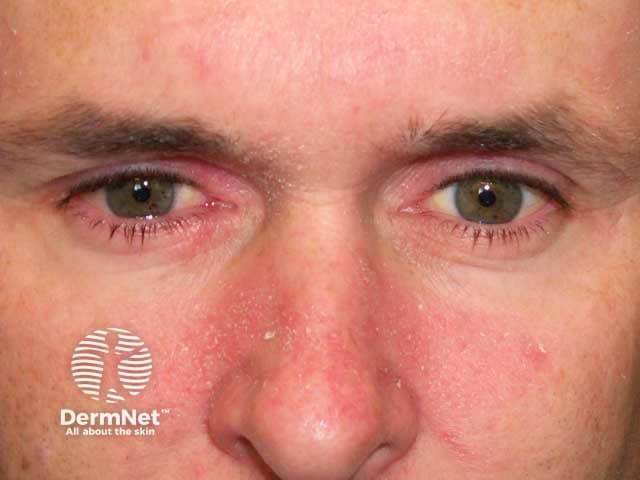
Seborrhoeic blepharitis and dermatitis on the cheeks
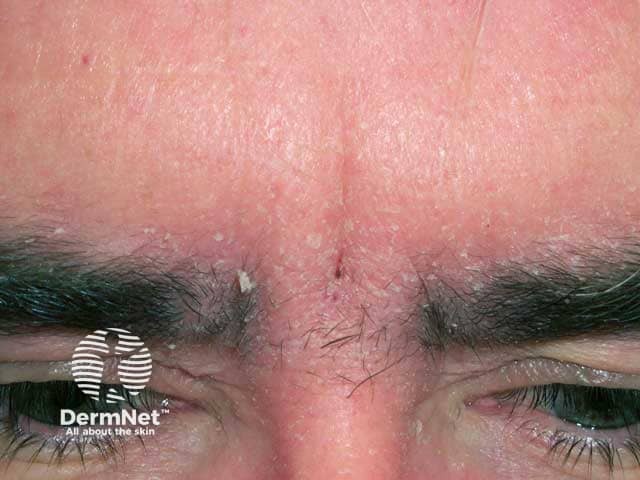
Scale and erythema due to seborrhoeic dermattis on the glabella and brows
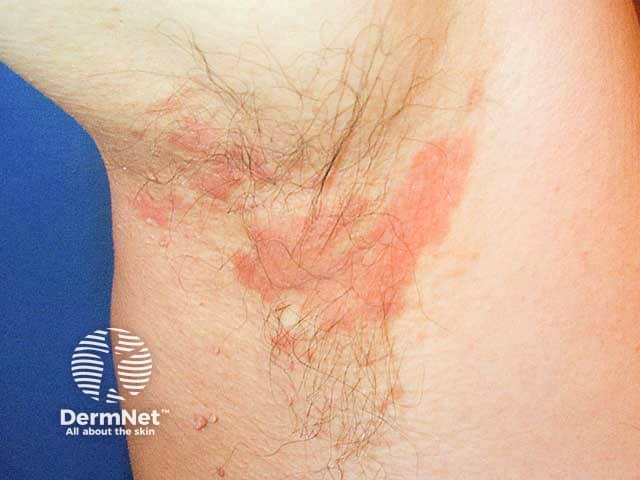
Flexural seborrhoeic dermatitis in the axilla
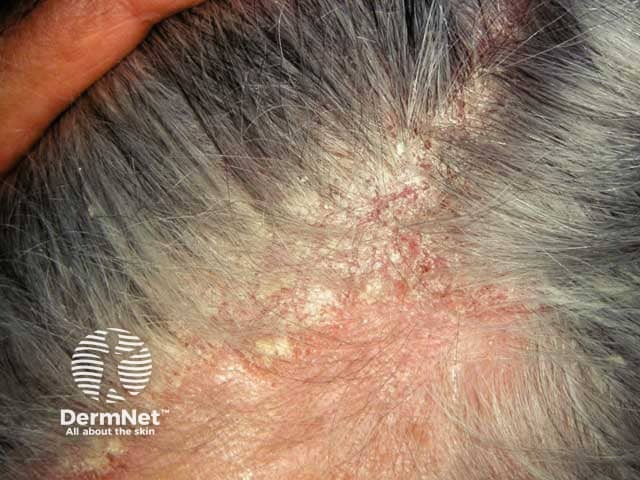
Confluent erythema and scale due to scalp seborrhoeic dermatitis

Presternal seborrhoeic dermatitis and pityrosporum folliculitis

Pigmented paranasal seborrhoeic dermatitis in skin of colour
Who gets seborrhoeic dermatitis?
Seborrhoeic dermatitis is a common skin condition affecting 3% to 12% of the population.
It has a biphasic incidence occurring in infants and in adolescents and adults.
Infantile seborrhoeic dermatitis affects babies under the age of 3 months and usually resolves by 6-12 months of age.
Adult seborrhoeic dermatitis tends to begin in late adolescence. Prevalence is greatest in young adults and in older people. It is more common in males than in females.
Seborrhoeic dermatitis often occurs in otherwise healthy patients. However, the following factors are sometimes associated with severe adult seborrhoeic dermatitis:
- Oily skin (seborrhea)
- Familial tendency to seborrhoeic dermatitis or a family history of psoriasis
- Immunosuppression: organ transplant recipients, human immunodeficiency virus (HIV) infection, and patients with lymphoma
- Neurological and psychiatric diseases: Parkinson’s disease, tardive dyskinesia, depression, epilepsy, facial nerve palsy, spinal cord injury, and congenital disorders such as Down syndrome
- Use of neuroleptic medications
- Treatment for psoriasis with psoralen and ultraviolet A (PUVA) therapy
- Lack of sleep, and stressful events.
What causes seborrhoeic dermatitis?
The aetiology is not completely understood.
Several factors are associated with the condition e.g. hormone levels, fungal infections, nutritional deficits, neurogenic factors. Proliferation of Malassezia yeast genus is believed to play a role. The lipases and phospholipases produced by Malassezia, a saprophyte of normal skin, cleave free fatty acids from triglycerides present in sebum. This may induce inflammation. Differences in skin barrier lipid content and function may account for individual presentations.
What are the clinical features of seborrhoeic dermatitis?
Infantile seborrhoeic dermatitis
Infantile seborrhoeic dermatitis causes cradle cap (diffuse, greasy scaling on the scalp). The rash may spread to affect armpit and groin folds (a type of napkin dermatitis).
- There are salmon-pink patches that may flake or peel.
- It is not especially itchy, so the baby often appears undisturbed by the rash, even when generalised.
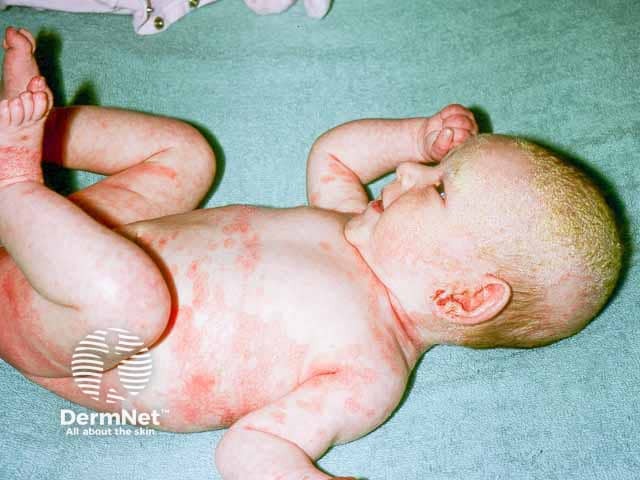
Infantile seborrhoeic dermatitis - note eczema in the napkin area and axillae and crade cap

Thick yellow scale in crade cap
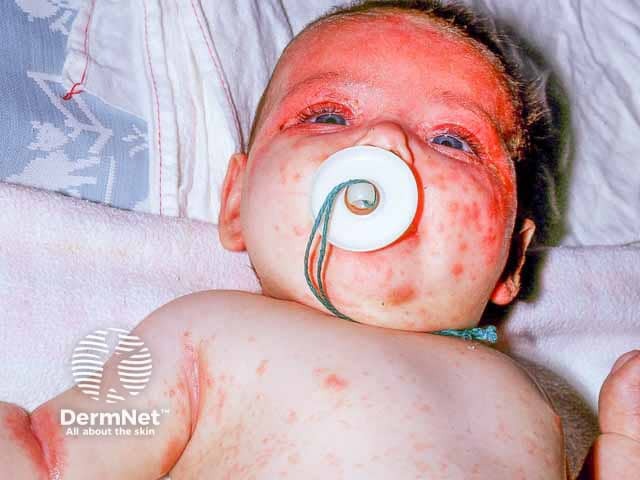
Inflammatory infantile seborrhoeic dermatitis – note lesions in the body folds
Adult seborrhoeic dermatitis
Seborrheic dermatitis commonly affects areas of the skin with high sebum production, such as the scalp, nasolabial folds, glabella, eyebrows, beard, ears, retroauricular skin, sternum, and other skin folds.
Typical features include:
- Winter flares, improving in summer following sun exposure
- Minimal itch most of the time
- Combination oily and dry mid-facial skin
- Ill-defined localised scaly patches or diffuse scale in the scalp
- Blepharitis: scaly red eyelid margins
- Salmon-pink, thin, scaly, and ill-defined plaques in skin folds on both sides of the face
- Petal or ring-shaped flaky patches on the hairline and on anterior chest
- Rash in the armpits, under the breasts, in the groin folds, and genital creases
- Malassezia folliculitis (inflamed hair follicles) on the cheeks and upper trunk.
Extensive seborrheic dermatitis affecting the scalp, neck, and trunk is sometimes called pityriasiform seborrhoeide.
How do clinical features vary in differing types of skin?
Seborrheic dermatitis is very common among patients of darker skin types. Studies have shown that it is among the five most common diagnoses observed in black patients.
People of darker skin may present with scaly hypopigmented macules and patches in typical areas of involvement. Arcuate or petal-like patches may be seen, termed petaloid seborrhoeic dermatitis.
Children of colour often do not experience the classic cradle cap appearance of seborrheic dermatitis, but instead have erythema, flaking, and hypopigmentation of the affected areas and folds of skin.
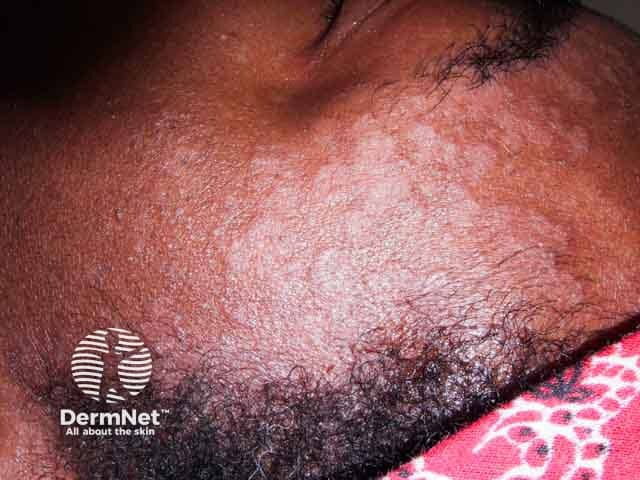
Seborrhoeic dermatitis around the hair line and forehead in skin of colour
What are the complications of seborrhoeic dermatitis?
- Secondary bacterial or fungal infection
- Skin thinning, dilated blood vessels, and steroid-induced telangiectasia
- Psychosocial impact due to appearance of skin
How is seborrhoeic dermatitis diagnosed?
The diagnosis of seborrhoeic dermatitis is a clinical diagnosis based on the location, appearance, and behaviour of the lesions.
If the diagnosis is uncertain, a biopsy can be undertaken. This would typically show parakeratosis in the epidermis, plugged follicular ostia, and spongiosis in the case of seborrhoeic dermatitis. The dermis typically has a sparse, perivascular, lymphohistiocytic inflammatory infiltrate.
As Malassezia are a normal component of skin flora, their presence on microscopy of skin scrapings is not diagnostic.
For information on trichoscopic (dermoscopy) findings in seborrhoeic dermatitis, see trichoscopy of inflammatory conditions.
What is the differential diagnosis for seborrhoeic dermatitis?
- Atopic dermatitis/eczema
- Candidiasis
- Contact dermatitis/eczema
- Erythrasma
- Impetigo
- Lichen simplex chronicus
- Nummular dermatitis/eczema
- Pityriasis rosea
- Psoriasis
- Rosacea
- Scalp psoriasis
- Secondary syphilis
- Systemic lupus erythematosus
- Tinea capitis, corporis.
What is the treatment for seborrhoeic dermatitis?
General measures
- Educating the patient about the skin condition and appropriate skincare routine.
- Identifying modifiable lifestyle factors e.g. a high fruit intake is associated with less seborrheic dermatitis whereas stress may precipitate flare-ups.
Specific measures
Treatment of seborrhoeic dermatitis often involves several of the following options.
- Keratolytics: used to remove scale when necessary, e.g. salicylic acid, lactic acid, urea, propylene glycol.
- Topical antifungal agents: applied to reduce Malassezia e.g. ketoconazole, or ciclopirox shampoo and/or cream. Note, some strains of Malassezia are resistant to azole antifungals. Try zinc pyrithione or selenium sulphide.
- Mild topical corticosteroids: for 1–3 weeks to reduce the inflammation of an acute flare.
- Topical calcineurin inhibitors: (pimecrolimus cream, tacrolimus ointment) are indicated if topical corticosteroids are needing to be used frequently, as they have fewer adverse effects on facial skin with long term use.
In resistant cases in adults, oral itraconazole, tetracycline antibiotics, or phototherapy may be recommended. Low-dose oral isotretinoin has also been shown to be effective for severe or moderate disease.
Roflumilast 0.3% foam has had recent FDA approval for the use of seborrhoeic dermatitis in patients aged 9 years and older.
Scalp treatment
- Medicated shampoos containing ketoconazole, ciclopirox, selenium sulfide, zinc pyrithione, coal tar, and salicylic acid, used twice weekly for at least a month and if necessary, indefinitely.
- Steroid scalp applications reduce itching and should be applied daily for a few days every so often.
- Calcineurin inhibitors such as tacrolimus can be used as steroid alternatives.
- Coal tar cream can be applied to scaling areas and removed several hours later by shampooing.
- Combination therapy is often advisable.
- Alternative treatments, such as tea tree oil shampoo, may be used.
Face, ears, chest, and back
- Cleanse the affected skin thoroughly once or twice each day using a non-soap cleanser.
- Apply ketoconazole or ciclopirox cream once daily for 2 to 4 weeks, repeated as necessary.
- Hydrocortisone cream can also be used, applied up to twice daily for 1 or 2 weeks. Occasionally a more potent topical steroid may be prescribed.
- Topical calcineurin inhibitors such as pimecrolimus cream or tacrolimus ointment may be used instead of topical steroids.
- A variety of herbal remedies are commonly used, but their efficacy is uncertain.
Management in infants
Regular washing of the scalp with baby shampoo or aqueous cream is followed by gentle brushing to clear the scales.
- White petrolatum may be useful.
- Topical antifungal agents are often prescribed, depending on the extent of the rash.
For more information, see infantile seborrhoeic dermatitis.
What is the outcome for seborrhoeic dermatitis?
While seborrhoeic dermatitis may be self-limiting, it may take a long period of time to resolve. Cradle cap in infants usually takes a few weeks or months to disappear. In adults, the condition is frequently chronic and long-term maintenance treatment is often necessary.
Bibliography
- Barak-Shinar D, Del Río R, Green LJ. Treatment of seborrheic dermatitis using a novel herbal-based cream. J Clin Aesthet Dermatol. 2017;10(4):17–23. PubMed Central
- Borda LJ, Wikramanayake TC. Seborrheic dermatitis and dandruff: a comprehensive review. J Clin Investig Dermatol. 2015;3(2):10.13188/2373-1044.1000019. doi:10.13188/2373-1044.1000019. Journal
- Cheong WK, Yeung CK, Torsekar RG, et al. Treatment of seborrhoeic dermatitis in Asia: a consensus guide. Skin Appendage Disord. 2016;1(4):187–96. doi:10.1159/000444682. Journal
- Clark GW, Pope SM, Jaboori KA. Diagnosis and treatment of seborrheic dermatitis. Am Fam Physician. 2015 Feb 1;91(3):185-90. Journal
- de Souza Leão Kamamoto C, Sanudo A, Hassun KM, Bagatin E. Low-dose oral isotretinoin for moderate to severe seborrhea and seborrheic dermatitis: a randomized comparative trial. Int J Dermatol. 2017;56(1):80–5. doi:10.1111/ijd.13408. Journal
- Elgash M, Dlova N, Ogunleye T, Taylor SC. Seborrheic Dermatitis in Skin of Color: Clinical Considerations. J Drugs Dermatol. 2019 Jan 1;18(1):24–7. Journal
- Sanders MGH, Pardo LM, Ginger RS, Kiefte-de Jong JC, Nijsten T. Association between Diet and Seborrheic Dermatitis: A Cross-Sectional Study. J Invest Dermatol. 2019 Jan;139(1):108–14. doi: 10.1016/j.jid.2018.07.027. Journal
- Schwartz RA, Janusz CA and Janniger CK. Seborrheic dermatitis: An overview. Am Fam Physician. 2006 Jul 1;74(1):125–32. Journal
On DermNet
- Diagnosis of scalp rashes
- Pityriasiform seborrhoeide
- Sebopsoriasis
- Pityriasis versicolor
- Malassezia folliculitis
- Dermatitis
- Psoriasis
- Pityriasis amiantacea
- Malassezia
- Cradle cap
- Leiner disease
- Trichoscopy of inflammatory conditions
- Trichoscopy
Other websites
- Seborrheic dermatitis — National Eczema Society
- Seborrhoeic dermatitis — British Association of Dermatologists
- Seborrheic dermatitis — American Academy of Dermatology
